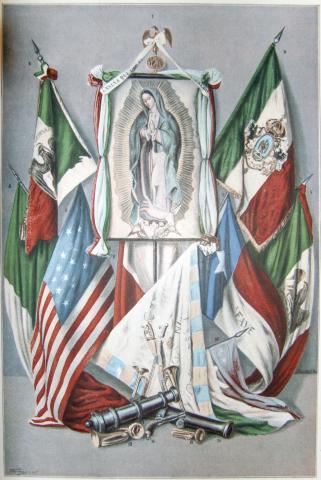On September 12 1847, U.S. troops stormed Chapultepec Castle in the last major battle for control of Mexico City. The following day Scott’s army seized control of two causeways leading into the capital. Realizing the city could no longer be defended, Santa Anna evacuated his army that night. Winfield Scott’s army entered the capital September 14, where it was greeted by public demonstrations and street violence. Angry mobs resisted the U.S. occupation for the next three days, prompting Scott to declare martial law. Resigning the presidency, Santa Anna gathered the remnants of the Mexican army and continued to fight U.S. troops. The Mexican government, headed by interim president Manuel Peña y Peña, chief justice of the Supreme Court, moved to Quéretaro, 130 miles north of Mexico City. Amid bitter recriminations over the fall of the capital, Peña y Peña relieved Santa Anna from command in early October.
In the months that followed, an attempt to hammer out a peace between the two countries was thwarted by domestic political considerations on both sides. In the United States, opposition to the war was gaining ground, even as some ultraexpansionists began to clamor for the complete annexation of Mexico by the United States (the “All Mexico” movement). Complicating the situation still further, President Polk had lost confidence in his diplomatic envoy, Nicholas Trist, recalling him in October. In Mexico, meanwhile, a coalition of moderates had emerged as the dominant faction in the wake of Santa Anna’s fall from power, and urged Trist to remain at his post. However, continued political infighting made it difficult to predict what course the Mexican Congress would ultimately take. In the end, Trist and a trio of Mexican peace commissioners signed the Treaty of Guadalupe Hidalgo on February 2 1848, by which Mexico ceded Upper California and New Mexico for $18 million to the United States. The U.S. occupying forces would remain until both governments formally accepted the agreement. Despite his anger at Trist’s insubordination, Polk referred the treaty to the Senate, which ratified the treaty with amendments on March 10 1848. It was subsequently approved by the Mexican Congress on May 19 1848. Only then did the new U.S. president, Zachary Taylor, give the order to withdraw U.S. forces. The last U.S. troops would leave Mexico on June 12 1848.
The eight-month long occupation of Mexico remains one of the least-studied aspects of the war. U.S. historians have generally assumed that the conclusion of street fighting in mid-September 1847 marked the transition to a peaceful occupation of the country by the U.S. army. However, the private journals, diaries, and letters of U.S. troops reveal the complexity of Mexican feelings toward foreign occupation. While some Mexicans collaborated with U.S. forces, sporadic, unpremeditated violence, as well as more generalized and organized forms of anti-American resistance continued long after the fall of Mexico City.






